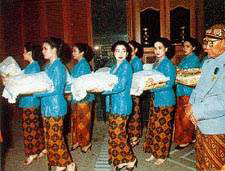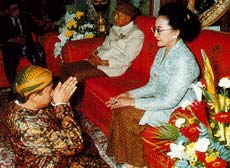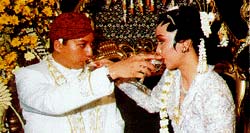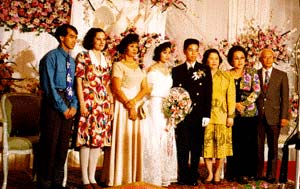Women in Very Tight Bridesmaid Dress Holdig Umbrella
Home » Practical Information » Indonesian Customs and Culture » Weddings
Indonesian Wedding Ceremonies and Customs
Ethnic Chinese Weddings
Sundanese Wedding Ceremonies
Karo Batak Wedding Ceremonies
Indonesian Wedding Links
 Count yourself fortunate if you've had the opportunity to attend an Indonesian wedding. The fascinating wedding ceremonies and festivities give expatriates a unique opportunity to gain insight into Indonesian culture and social mores.
Count yourself fortunate if you've had the opportunity to attend an Indonesian wedding. The fascinating wedding ceremonies and festivities give expatriates a unique opportunity to gain insight into Indonesian culture and social mores.
Given the broad diversity of ethnic groups in Indonesia, it stands to reason that wedding customs will reflect this diversity. Each ethnic group has different wedding dress (batik, traditional textiles, kebaya) and different marriage ceremonies and customs. Within ethnic groups, those of different religious backgrounds will have different practices as well.
As a expatriate living in Indonesia you may on occasion receive a wedding invitation. You may not know how to act, what to bring or what your role as a guest in the wedding should be. We'd like to outline what happens at most weddings in Indonesia to help prepare you. If in doubt, consult colleagues or friends that you know have been invited or ask colleagues or your secretary to determine what appropriate dress and gift would be.
Attendance is Important
A wedding is a very important event in Indonesian culture and is considered the starting point of a new aspect of a person's life, therefore normally everyone wants to help the couple celebrate this occasion. Literally every relative, acquaintance, colleague or business partner could be invited to the wedding. Joining a group of others that are invited, even if you did not receive an invitation personally addressed to you, is normal (as long as it's not a sit down dinner - in which case the number of invitees is clearly stated on the invitation).
 Indonesians are truly honored by your attendance at a wedding. Attending shows that you care, that you respect the people involved and your relationship with them, that you honor the family and want to show your support of the newlyweds. Don't question the intent of colleagues or subordinates who, upon short acquaintance, invite you to their daughter's or son's wedding. They really do want you to come!
Indonesians are truly honored by your attendance at a wedding. Attending shows that you care, that you respect the people involved and your relationship with them, that you honor the family and want to show your support of the newlyweds. Don't question the intent of colleagues or subordinates who, upon short acquaintance, invite you to their daughter's or son's wedding. They really do want you to come!
On the other hand, not responding to the invitation, or not attending a wedding that a close colleague has invited you to can cause a significant insult and slight to the giver, which can cause problems in your relationship in the future. Having said that ... you are not obligated to attend every wedding that you receive an invitation for. Although people that you do not have a close relationship with may give you an invitation, it is understandable if you send regrets for not being able to attend.
The Invitation
Wedding invitations in Jakarta and other urban centers can be very extravagant. The date on the outside of the envelope is very practical if you receive many wedding invitations. In rural areas, the invitation is done via visits from the family to neighbors and friends.
The sincere welcome extended to guests is noted on the invitation with wording such as "Merupakan suatu kehormatan & kebahagiaan bagi kami apabila Bapak/Ibu/Saudara/i berkenan hadir untuk memberikan doa restu kepada kedua mempelai" or "Tiada yang dapat kami ungkapkan selain ucapan terima kasih dari hati yang tulus atas kehairan serta pemberian doa restu Bapak/Ibu/Saudara/i kepada putra-putri kami". Both of these phrases mean that you do the family great honor by attending and extending blessings upon the bride and groom.
On the invitation will be noted the date, time and place for the Akad Nikah, which is the actual wedding ceremony, as well as the Resepsi Pernikahan, which is the wedding reception. Even though both ceremonies are noted on the invitation, the majority of people will only attend the reception.
as well as the Resepsi Pernikahan, which is the wedding reception. Even though both ceremonies are noted on the invitation, the majority of people will only attend the reception.
If you would like to attend the wedding ceremony, as this is when most of the cultural ceremonies take place, be sure to ask the person who gave you the invitation if this would be okay. They will probably say yes, but it's best to clear it first as usually a much smaller crowd or just close family members are expected to witness the actual exchange of marriage vows.
Appropriate Dress
For women, nice dresses, much as you would wear to a wedding at home. For men, a business suit or a long-sleeved batik shirt with slacks.
It would be appropriate to wear a long sleeved dress to a Muslim wedding reception. It is not necessary for an expatriate woman to cover her head, though many of the Indonesian attendees may do so.
The Gift
In the past (as in the 80s and early-90s), the grand, glorious, conspicuously extravagant weddings in Jakarta were gifted with large floral displays which were placed outside the reception hall. Or, wedding guests brought a wide variety of household goods as gifts. In a large wedding, to which thousands of people may be  invited, there would be many duplications of gifts. It would not be unusual at every large wedding for the wedding couple to receive, for example, 15 blenders, 20 mixers, 10 toasters, 25 rice cookers, 5 refrigerators, 3 cars, etc.
invited, there would be many duplications of gifts. It would not be unusual at every large wedding for the wedding couple to receive, for example, 15 blenders, 20 mixers, 10 toasters, 25 rice cookers, 5 refrigerators, 3 cars, etc.
Therefore, a relatively new practice arose in the mid-90s whereby the wedding couple asks the attendees not to bring gifts or floral displays by the inclusion of additional wording on the invitation "Dengan tidak mengurangi rasa hormat dan terima kasih, akan lebih bermanfaat seandainya ungkapan kasih sayang yang mungkin akan diberikan kepada kami tidak berupa cendera mata atau karangan bunga" or "Dengan tidak mengurangi rasa hormat kami, akan sangat berterima kasih apabila tanda kasih yang akan diberikan tidak berupa cenderamata atau karangan bunga". This translates as, Without belittling your generosity, we'd appreciate it if you didn't give us flowers or a gift.
This is a nice way of asking for money instead of gifts. At the reception desk there will be a beautifully decorated box with a slit in the top into which you can insert an envelope with money. If you choose to give money and are uncertain of an appropriate amount to give, ask your secretary or Indonesian colleagues for their suggestions. Sometimes the hostesses will number your envelope as well as next to your signature in the guest book, so that the bride and groom know how much money you gave.
Having said this, you are not obligated to bring a gift to the wedding.
Thank Yous
Don't expect a thank you note after the wedding for your gift. In many weddings attendees are given a small token upon their arrival, a fan, key chain or other item. Attached to this item will be a thank you for your attendance.
Wedding Receptions
The difference in the income level of the individuals will, needless to say, have a great bearing on the extent of the wedding celebrations. Weddings in Jakarta range from simple meals in the family home, to small receptions in community centers to grand extravagant affairs in the Jakarta Convention Center or 5-star hotel ballrooms.
At most wedding receptions, the guests arrive, sign the guest book, accept their thank you token, deposit their gift and enter the reception hall.
 The path into the reception hall will be flanked left and right with members of the extended families, often dressed in similar traditional dress or formal attire. A smile and nod and sometimes a handshake if they offer their hand to some of these people would be appropriate. Following the family members may be young men and women holding a chain of flowers. This is called the pagar ayu or 'fence of beauty'.
The path into the reception hall will be flanked left and right with members of the extended families, often dressed in similar traditional dress or formal attire. A smile and nod and sometimes a handshake if they offer their hand to some of these people would be appropriate. Following the family members may be young men and women holding a chain of flowers. This is called the pagar ayu or 'fence of beauty'.
If you arrive on time you will be able to witness the procession of the wedding couple into the reception hall. Depending on the wealth, social standing or ethnic group, this procession can be quite impressive. The bride and groom may be proceeded by dancers who give a traditional dance performance before the wedding couple goes on stage. Or the performance may come after the bride and groom are seated. The parents of the bride and groom and other senior family members will follow the couple in procession into the room.
Then come the speeches! A representative of each family will address the crowd to thank them for their attendance and sometimes an expression of regret if any arrangements for the reception are lacking or found wanting. Depending on whether or not you have one or two representatives speak, the speeches can be very brief or take up to half an hour.
After the speeches, the guests are invited to come to the stage and shake the hands of the bride and groom and their parents. Depending on the number of guests this receiving line can go on for hours. Traditional music may be played throughout the reception, if it is a traditional Indonesian wedding. If the wedding is a more western type, a mixture of foreign and popular Indonesian songs will be played.
played throughout the reception, if it is a traditional Indonesian wedding. If the wedding is a more western type, a mixture of foreign and popular Indonesian songs will be played.
After going through the receiving line, the guests are invited to eat. The feast can be quite extensive and is a good opportunity to try cuisine from different regions. It could be as simple as nasi goreng or bakmi goreng, ikan asem-manis to the more elaborate where there will be food stalls with sushi, tempura, kambing guling, dim sum, beef Wellington and other western dishes. Once the speeches are complete, it is also acceptable to eat first and then join the receiving line after your meal if the line is quite long.
When should you arrive and how long should you stay?
While some attendees will arrive early, the timing of your arrival should be determined by whether or not you want to see the procession and hear the speeches. If you do want to, you should come on time. If you. d rather miss the grand entrance and speeches, you can come 30-60 minutes after the time noted on the invitation. Then you can enter immediately into the reception hall, shake hands and proceed to the buffet tables.
 The length of time you spend at the reception is entirely up to you. Many Indonesians may only stay 15-30 minutes to eat a small snack after shaking hands, especially if they have another invitation to attend that night. Some people can even have up to 5 or 6 wedding invitations for one evening! If you are enjoying the splendor and the food, know lots of the attendees and enjoy the chance to chat, stick around and enjoy yourself. If, on the other hand, you don't know anyone who is there, it is acceptable to shake hands, eat and leave promptly (SMP-sudah makan pulang-when you've finished eating you can go home :). In a small wedding you will shake hands again before leaving.
The length of time you spend at the reception is entirely up to you. Many Indonesians may only stay 15-30 minutes to eat a small snack after shaking hands, especially if they have another invitation to attend that night. Some people can even have up to 5 or 6 wedding invitations for one evening! If you are enjoying the splendor and the food, know lots of the attendees and enjoy the chance to chat, stick around and enjoy yourself. If, on the other hand, you don't know anyone who is there, it is acceptable to shake hands, eat and leave promptly (SMP-sudah makan pulang-when you've finished eating you can go home :). In a small wedding you will shake hands again before leaving.
Don't expect that alcohol will be served at the wedding reception or that there would be dancing, this is highly unlikely. Likewise, coming to a wedding after drinking would be considered very rude. Some couples that have spent time overseas may have a wine and beer bar at their reception, however this is not common and in most cases guests will only drink moderately at a reception.
Indonesian Ethnic Weddings
The primary differences between wedding receptions of different ethnic groups would be in the style of wedding dress, stage decorations, food served and the dance performance. Besides that, most weddings follow somewhat predictable patterns as described above. More differences would be evident in the traditional wedding ceremonies than in the receptions.
Ethnic Chinese Weddings
On the surface, ethnic Chinese wedding receptions may seem more similar to western weddings, due to the  adaptation of western wedding dress and the wedding cake. But that may be the extent of the similarities.
adaptation of western wedding dress and the wedding cake. But that may be the extent of the similarities.
About a week before the wedding, the family of the groom will go (without the groom) to the house of the bride bringing various gifts that are arranged in red baskets or red boxes or other red containers. Red symbolizes happiness and prosperity for the Chinese. Each basket should be carried by a member of the immediate family of the groom. The contents of the basket determines who should carry each basket.
The baskets from the groom should all be carried by males. They contain various items, such as fruit in one basket, clothes in another, gold jewelry for the bride in another. Some are gifts from the groom and others are gifts from the family of the groom. Another basket contains 'uang susu' (milk money). Depending on the wealth of the family the gifts will be more or less generous.
The bride's family then accepts the baskets and takes them off to another room. Then, they sort through the gifts. Normally half of the gifts are placed back in the baskets and returned to the family of the groom. The basket is then returned to the person that brought it and everybody goes home.
Three days before the wedding, the bride's family returns the favor and brings red baskets to the groom's house. These baskets are carried by females of the bride's immediate family. The baskets normally contain clothes for the groom, shoes and fruit. Basically, things that he would use everyday.
These baskets are carried by females of the bride's immediate family. The baskets normally contain clothes for the groom, shoes and fruit. Basically, things that he would use everyday.
Some of the baskets contain makeup and personal things for the bride, such as nightgowns. This symbolizes that the groom's family is accepting her into their house. On her wedding day when she moves in, all of her personal belongings will already be in the groom's house. Again the gifts are sorted through and about half are returned.
Different ethnic Chinese groups will have variations on these proceedings, some more strictly adhered to than others. For example, Hokian, Cantonese or Kai have slight variations on these customs. For some, the groom's family will be invited into the new couple's bedroom after the bride's gifts have been received into the house and they will be invited to have a 'closet inspection'. It is expected that the bride has placed her things neatly in the closets indicating that she will be a good housekeeper.
 On the morning of the wedding day, the groom is symbolically dressed by his parents (helping him put his jacket on and his flower on his lapel). Then the groom and his parents would go to the house of the bride. The wedding couple would serve tea to both sets of parents while kneeling down in front of them. This symbolizes paying their respects as well as asking permission of their parents.
On the morning of the wedding day, the groom is symbolically dressed by his parents (helping him put his jacket on and his flower on his lapel). Then the groom and his parents would go to the house of the bride. The wedding couple would serve tea to both sets of parents while kneeling down in front of them. This symbolizes paying their respects as well as asking permission of their parents.
The bride and groom would then go to the church, together in the same car, for the service. The church service is not really considered that important and only immediate family normally attend. The more important event to attend is the reception.
After the church service, the newlyweds proceed to a professional photo studio and have their picture taken in many poses as a memento of the day. After the photo session, the newlyweds go on to the reception that is usually a standing only event.
The reception is run by an MC, usually someone who is hired to do the job. The reception begins with a speech of welcome from the MC.
The speech is followed by cake cutting ceremony. The wedding cake is usually a monstrous size. Normally it is  lapis Surabaya (a layer cake) as the layers symbolize a ladder that you can climb up to success. It is also for this reason that some couples will cut the cake from the bottom layer and work their way upwards rather than starting at the top and working their way to the bottom!
lapis Surabaya (a layer cake) as the layers symbolize a ladder that you can climb up to success. It is also for this reason that some couples will cut the cake from the bottom layer and work their way upwards rather than starting at the top and working their way to the bottom!
The cutting of the cake is usually the only event at the reception. The bride and groom cut the cake together and then feed the cake to each other with entwined arms, trying not to destroy the bride's elaborate makeup in the process. Then a piece of the cake would also be cut for each of the parents and grandparents and they too would be fed by the bride and groom holding the cake together.
After the cake cutting, and sometimes a toast, the guests are invited to shake hands with the newlyweds and their parents on the stage. In all weddings there is some musical entertainment as the attendees line up to shake hands. This could be as simple as a man with a keyboard up to the Jakarta Symphony or Twilight Orchestra. You would also shake hands again when you are going to leave.
At more elaborate ethnic Chinese weddings, there could be a sit-down wedding reception. If this is the case, expect an elaborate 9 to 10 course meal. It could feature Chinese cuisine only, or be mixed with western dishes as well. There could be a female singer for entertainment. Occasionally, friends or family members will get up from the audience to sing for the wedding couple. The head tables will usually get a bottle of cognac or whiskey. At the weddings of the very wealthy, beer, wine or champagne maybe served to the guests.
Most of the ethnic Chinese customs that a decade ago would have been compulsory are being ignored by the younger generation today. Most of the customs that are carried out are done so to satisfy parents' wishes.
Sundanese Wedding Ceremony
Some common practices from a traditional Sundanese (West Java) wedding ceremony:
Welcoming the bridegroom ceremony
- The bridegroom is welcomed with the umbul-umbul, a decoration indicating that a wedding ceremony is going on, which is also auspicious for the bridegroom.
- The welcome is followed by a procession of ladies with candles. They pray to the Almighty seeking His blessing in order that there maybe no hindrances in the ceremony.
- The showering of flowers by the dancers is symbolic of a fragrant future for the couple.
- The umbrella held over the couple's heads, apart from serving as a protective symbol, indicates esteem and respect.
- The mother of the bride gives the bridegroom a garland of flowers indicating his acceptability to the family.
- The mother of the bride gives the bridegroom a keris, a hidden message to the son-in-law not to be disheartened while toiling for his family.
Wedding ceremony
The bride and groom are seated next to each other with a selendang or veil covering their heads indicating two people but having one mind.
The bride and groom bend forward and kiss the knees of their parents, called sungkem, asking for forgiveness and blessing and reassuring them that they will continue to serve their parents.
Sawer
This ceremony should take place in front of the sawer or gargoyle. The water flowing from the gargoyle indicates the continuous flow of priceless parental love for their children.
The bride and groom are seated under an umbrella in front of the entrance to the house. There are two singers, a man and a woman, who sing on behalf of the parents. The song, called kidung, advises the couple to treat each other well, living in harmony, and serves as a prayer to the Almighty to bless the couple.
Then the sawer is showered on the couple. It consists of:
Turmeric rice Rice is a sign of prosperity and yellow stands for everlasting love
Coins Reminding the couple to share their wealth with the less fortunate
Candy Indicates sweetness and fragrance throughout their marriage
A betel nut set near the couple is a reminder that their different customs should not spoil their harmonious marriage.
Nincak Endog
This is the egg breaking ceremony. The couple are required to stand facing each other in front of the entrance of the house. The bridegroom stands outside the entrance and the bride is inside the entrance.
This ceremony is conducted by the lady in charge of the bridal makeup and serves as advice to the couple for their happiness and long wedded life.
The following items are used:
a. Harupat, seven broomsticks, are burnt and thrown away symbolizing the discarding of bad habits which endanger one. s married life.
b. An egg is broken, indicating that the groom will be the master of the house henceforth and the bride will serve him.
c. Ajug, seven candles, represents the direction the couple should follow to ensure a happy married life.
d. Elekon, hollow bamboo, which symbolizes emptiness.
e. Kendi, an earthen water jug filled with water, which stands for peace.
f. In the past, unmarried girls were not allowed to cross over logs. Here the bride is made to cross the log as a sign that she will always obey her husband.
The lady in charge of the ceremony gives the bride the harupat. The groom lights the harupat with the ajug. Then the flames are put out and the sticks are broken and thrown away. After the groom breaks the egg with his right foot, the bride cleans the groom's foot with the water from the kendi. Then the bride throws the kendi to break it.
Then the couple are escorted to the house. The bride crosses the log and enters the house while the groom remains outside to perform the buka pintu ceremony.
Buka Pintu
This is a dialogue between the bride and groom in front of the house. However, they are represented by a couple who also sings for them. First, the couple knocks three times on the door, then enters into a dialogue whereby permission is requested by the groom to enter the bride's house. The bride consents on the condition that the groom will say the syahadat (confirming his Moslem faith). The song also solemnizes the importance of the nuptial ceremony.
Huap Lingkung
Symbolic of the last time the parents of the bride will feed their daughter. This is also the first dish prepared by the daughter in her new home. The dish consists of turmeric sticky rice with yellow spiced chicken on top of it.
Patarik-Tarik Bakakak
The couple are given a barbecued spiced chicken. On hearing the word 'go' from the lady conducting the ceremony, the couple has to pull the chicken apart. The one who gets the larger piece supposedly will bring in the larger share of the family fortune. This ceremony also serves to remind the couple to encourage each other to work hard together to gain good fortune.
![]()
Indonesian Wedding Links
Getting Married in Indonesia
Wedding Catering in Bali
Bruce and Yanti's Balinese Hindu wedding
Beautiful and Memorable Wedding Venues in Indonesia
For a small, intimate wedding in a tranquil garden setting, The Watergarden in East Bali is the perfect location. From the simplest Balinese Blessing Ceremony through to a full religious and legal ceremony, the hotel can arrange every detail.
Spectacular volcanic mountain backdrops and verdant scene are the perfect venue for a memorable wedding at the MesaStila Spa Retreat & Coffee Planation in Central Java.
makinsonfoughurpite.blogspot.com
Source: https://www.expat.or.id/info/weddings.html
0 Response to "Women in Very Tight Bridesmaid Dress Holdig Umbrella"
Post a Comment